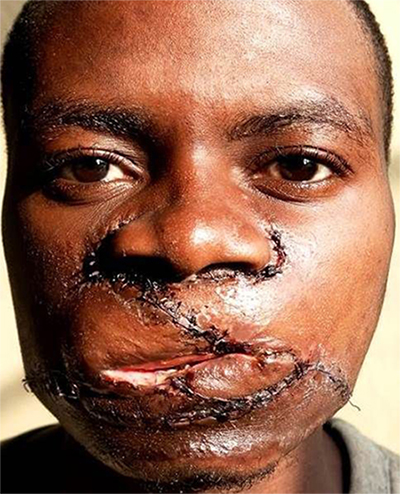When : 18.März 2023
Where : Rehema Goma Hospital

Today's opening of the REHEMA hospital in Goma was a big event in this city of 2 million people. I had to fly to Goma in my old age because our Interplast Chairman Dr. André Borsche was on a similar mission for our 3rd Interplast- Sushma-Koirala-Memorial Hospital in Nepal
With a large contingent and lots of Kalashnikovs, a powerful but very friendly military governor came to the opening - who asked me in German on his arrival “Where is the nearest bus stop?” (he had studied in Belgium near the German border). He spontaneously agreed to sign a contract with the Nazarene Church that his government would take over the hospital in the event of a financial emergency and incorporate it into the medical faculty of the University of Goma. He spoke for half an hour, was enthusiastic, asked about the function of the equipment in every room, and spent 3 hours in front of and inside the hospital. Afterwards, a large buffet was opened and danced to drums.
Mission accomplished.
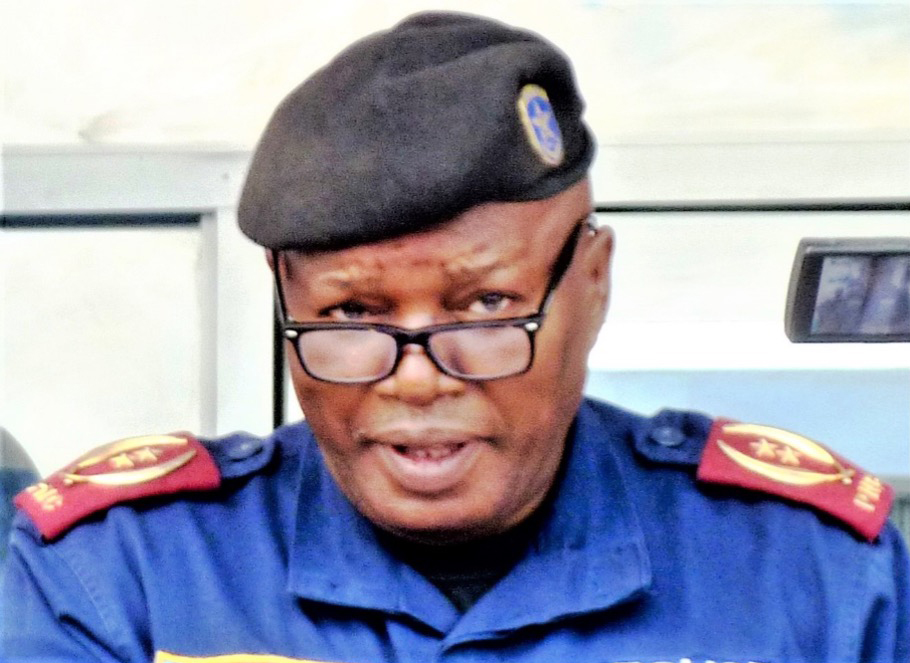
Military Governor General EKUKA LIPOPO at his inauguration speech, a great leader in a city of 2 million surrounded by rebels
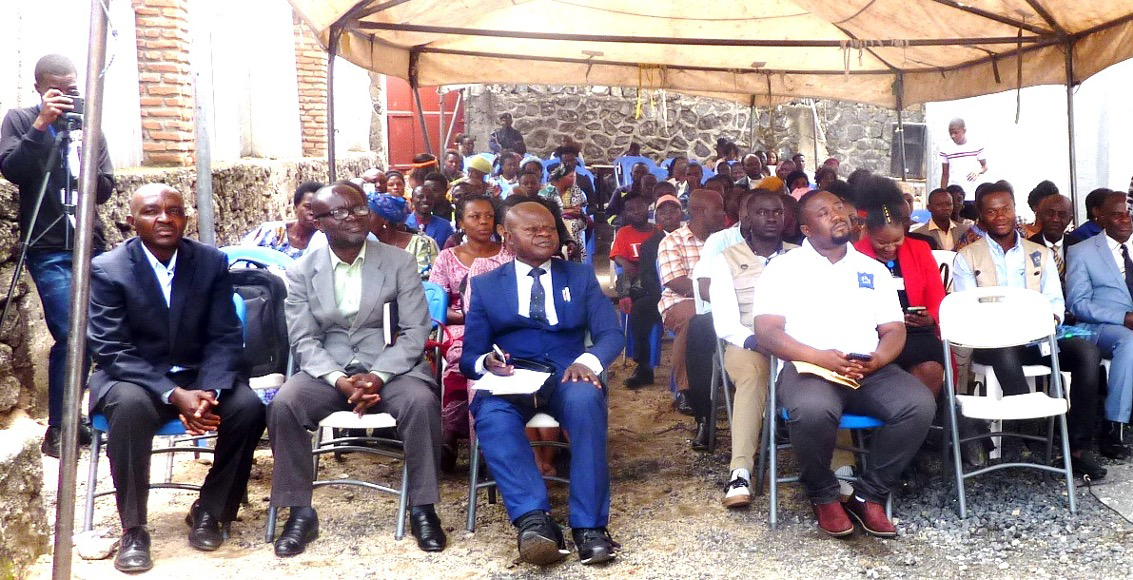
Around 120 invited guests were present under 3 tent roofs
Unfortunately, the leaders of the Nazarene Church from the USA did not show up, although they were scheduled as speakers on the program. They happened to be in Goma to ordain 10 young pastors, but had allegedly been informed too late and didn't even want to see the hospital that INTERPLAST-Germany will be donating to their church in the foreseeable future!
Many thanks to all major, minor and permanent donors! The shell of the 1st floor for children and women is almost complete - and will be ready to move in at the beginning of 2024. A gynaecologist specializing in fertility, Dr. Daniel Mpez, is already holding consultation hours and his midwife Madame Dorcas is currently delivering a newborn every few days.


Op boss Colette and lab technician Judite with my internet portrait from earlier years...
Finding an experienced surgeon, on the other hand, is difficult because our current Dr. Kimona charges $3000 a month - while the other doctors have to make do with $500. But Dr. Kimona comes for difficult cases; maybe we can convince him after all?- Due to the high cost of special medical training of around $25,000, specialists are only available at universities - and those who were lucky enough to study abroad because of their rich parents get married there and never come back.
We are currently making ends meet, outside of the construction costs, with a monthly subsidy of around €5000 on top of the $3000 we have earned ourselves - with monthly salaries of around $5000 and hope for increasing numbers of patients for births, operations and consultations.
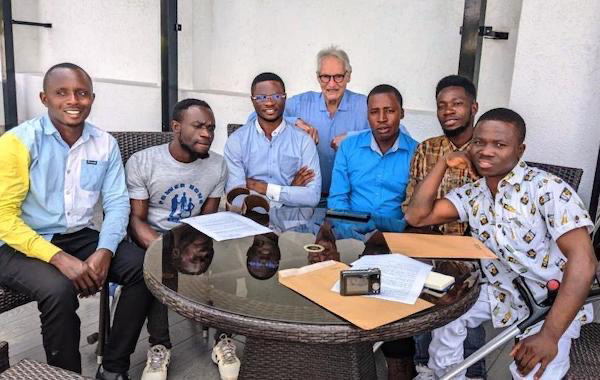
In the afternoon there was a founding meeting of the (ADHC) with the spokespersons of existing disabled people's organizations to push through a law that obliges state institutions and larger companies to employ 3% disabled people.
Gottfried Lemperle at the opening of the 4th INTERPLAST hospital REHEMA (Mercy) in Goma, Congo
Author : Hans Jakob
When : November 2022
Where : Rehema Goma Hospital

After two years of construction, the first floor of the 4th INTERPLAST hospital “REHEMA (Mercy) Centre Hospitalier” in Goma, Congo on the border with Rwanda was ready for two INTERPLAST teams to inaugurate the operating theaters in November 2022.
The 1st team with Dr. Christoph Sachs, who had already operated with me three times in Goma, and his anaesthetist Dr. Philipp Kloss had to wait in the first week of 14.11. to 24.11.23 for the container from China - with all the medical equipment such as anaesthesia apparatus, operating equipment, X-ray and ultrasound, which was detained for 4 weeks by a customs officer in the port of Dar-es-Salaam.
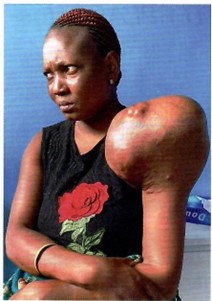

For similar reasons, the second container with IKEA kitchens and office furniture bought in Germany arrived in Goma 4 weeks late, so that both of them were initially busy unpacking and connecting the appliances. My son-in-law's father flew to Goma three weeks earlier to assemble the furniture and had to leave without having achieved anything on the day the containers arrived.
Christoph Sachs and Philipp Kloss were able to operate on the most difficult patients in the second week and achieve tremendous things in the process.
The 2nd team under Prof. Peter Sieg with anaesthetist Jens Hennike and his wife (Fig. 5) joined them on 20.11.22, but first had to unpack boxes and make connections. But then the team and the local anaesthetists and young guests came together for difficult operations and made an excellent impression in Goma. In total, 104 patients were operated on by the two teams in the three weeks.

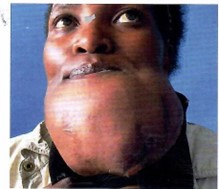
One more thing about the future of the hospital: the future gynaecologist Dr. David Kapagama will initially start on the first floor in spring 2023 after his specialist examination in Egypt, and if everything goes so well, a paediatrician and infectiologist will join him in 2024, and if necessary a traumatologist and other specialists as consultants.
The newly founded medical faculty of the University of Goma (UNIGom) has already registered its interest as a teaching hospital and the Minister of Health has already signaled his agreement that the hospital will go to the state if it is not self-sustaining after 5 years of our financial support. The state will pay the salaries of the employees from the official opening on March 18, 2023.
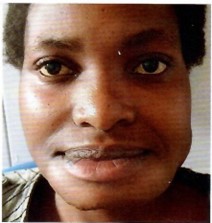

The staff, consisting of 5 doctors, 6 nurses and 5 others, are extremely proud of their new workplace. The REHEMA Hospital now seems to be known throughout Goma, so that the 33 beds will be fully occupied at the official inauguration by the Superintendent of the Nazarene Church for Africa on March 18, 2023.
A second practical inauguration of the hospital took place in the new year, on January 8, 2023, when the young doctor Salomon had to deliver a mother of a child by caesarean section. The parents gave their newborn the 3rd name Gottfried. But it was a girl and I was able to quickly arrange for her to be baptized Frieda, like two girls before her.

Gottfried Lemperle for the first two Interplast teams in the newly built Interplast Hospital
Author : Hans Jakob
When : January 11, 2022
Über : Interplast Germany
“It is not our fault that we were born into a world of prosperity and optimal medical care. It is not their fault to grow up with a deformity or burns in a developing country where there is no plastic surgery for the poor. Let's try to compensate for this injustice of nature“ - as far as it is in our power.”
This is the motivation for many humanitarian organizations to become active in developing countries. Alongside other medical disciplines, plastic surgery is particularly suitable for achieving optimal surgical results even under minimal technical conditions due to its low diagnostic effort. Plastic surgeons have therefore organized themselves in many nations to bring help to those who have no access to plastic surgery in their own countries.
INTERPLAST-Germany e. V.
Impressed by the idea of direct plastic surgery aid in developing countries, Gottfried Lemperle founded INTERPLAST-Germany in Frankfurt in 1980 and was himself amazed at how quickly the spark was passed on to his senior physicians. Many colleagues in Germany and soon also in Europe organized teams themselves, making the INTERPLAST idea a self-runner. In the first 10 years, almost 50 teams operated on over 3200 patients in developing countries.
In contrast to Interplast-USA, where strict centralization determines and organizes all missions from team composition to the last swab, in Germany each team leader has always been called upon to personally determine his or her mission location, organize his or her team, beg for suture material and medication, and give presentations for further donations after the mission has been completed. This personal responsibility undoubtedly increases the motivation to optimize one's own missions, while INTERPLAST-Germany e.V. takes care of insurance, additional financing and compliance with the framework conditions in the background.
Since 2020, Andre Borsche has been organizing and leading Interplast-Germany for a second time as Chairman in Bad Kreuznach to many missions and worldwide aid. All personnel activities are carried out on a voluntary basis without any expense allowances. Only the INTERPLAST secretary receives a small salary, whereby she invests many times more time out of personal enthusiasm for the “good cause”.
We are committed to our many small and large donors and keep our administrative costs below 5%. This includes the printing of the annual magazine with a circulation of almost 5,000 copies, which acts as a forum and official flagship of our association. We resist any form of commercialization and recruit donations through individual campaigns and personal donor care. In the age of “donation mailings”, it is precisely the “unprofessional” nature of our donation philosophy that is often perceived as appealing and rewarded by many loyal donors.
INTERPLAST Symposium
Since 2001, an INTERPLAST Symposium has been held every year in March in Bad Kreuznach, which has become a popular meeting place for international activists. The idea of cooperation is becoming increasingly important here and the symposium offers an ideal platform for integrating doctors from different specialties as well as nurses for the benefit of the aid projects. This is the only way we can build on long-term cooperation and promote the sustainability of our work.
And so André Borsche is delighted with the 180 congress participants who engaged in lively discussions and expressed how important it is to them to exchange experiences in an atmosphere of trust and friendship, as we can only learn from each other.
INTERPLAST Academy
On the initiative of its former senior physicians Dietmar Scholz and Nuri Alamuti in Wiesbaden, experienced INTERPLAST members will offer internal training and preparation for those interested in the field. This academy was first held in Wiesbaden in 2008 on the subject of “Burns” and will be continued on a regular basis due to the great demand. By printing a small English paperback “Camelbook” by Dutch surgical nurse Greta Hesseling on plastic surgery techniques, we are also providing interested nursing staff, students and trainee doctors in the countries of operation with something they can use to familiarize themselves with our specialist field for the first time.
INTERPLAST structure
In contrast to Interplast-USA, where a strict centralization determines and organizes all missions from team composition to the last swab, in Germany each team leader has always been personally called upon to determine their mission location, organize their team, beg for suture material and medication, and give presentations for further donations after the mission has been completed. This personal responsibility undoubtedly increases the motivation to optimize one's own missions, while INTERPLAST-Germany e.V. takes care of insurance, additional financing and compliance with the framework conditions in the background.
INTERPLAST sections
The decentralized association structure of INTERPLAST in Germany is reflected in the establishment of 12 sections, each of which manages its own projects for which it is responsible. They take care of the donations and are supported by the INTERPLAST main account if required. In this way, enthusiastic team leaders became committed section leaders who grouped INTERPLAST sympathizers around them in their personal environment. In 1988, the Stuttgart section under Werner Widmaier, the Munich section under Heinz Schoeneich, the Duisburg section under Peter Preissler and Jürgen Toennissen, the Frankfurt section under Hermann Lampe, Marianne Wolters and Ortwin Joch, the Eschweiler section under Hans-Elmar Nick, Wolfgang Buntenbroich and Matthias Gensior, the Nepal project in Hennef under Hein Stahl and Gottfried Lemperle, the Bad Kreuznach section under André Borsche, the South Baden section under Günter Zabel / Schopfheim and Martin Schwarz / Freiburg, the Vreden section under Arnulf Lehmköster, the Siebengebirge section under Michael Schidelko / Bad Honnef, the South Bavaria section under Andreas Schmidt / Murnau, the Baden-Baden/Rastatt section under Rüdiger Herr and Dieter Voy from Hattingen, who founded his own support association “pro-Interplast Ruhrgebiet”.
INTERPLAST activities
INTERPLAST-Germany organizes around 60 missions per year in which over 4000 patients are helped free of charge through plastic-reconstructive surgery. The locations are in Africa, Asia, South and Central America and are chosen irrespective of race, religion or political affiliation. The sole aim is to provide direct help for socially disadvantaged patients and to support local medical staff in the sense of helping people to help themselves. The average cost of treatment per patient is currently E 150.
While Interplast-USA sends organizers for the mission in advance, and then pediatricians, social workers, psychologists, speech therapists and orthodontists, aftercare assistants, etc., i.e. teams of 16-20 active participants, we deliberately make do with far fewer. As guests, we don't want to overwhelm the hosts with our presence, but rather integrate ourselves into the host hospital with respect. Our teams therefore consist of 4 to a maximum of 10 participants, usually comprising 2 experienced surgeons, 2 assistants, 2 anesthetists, 2-3 nurses and 1 student.
In any case, we are happy to involve the local staff and to include them in the responsibility for the aftercare of our joint patients. However, this is only possible if we consciously strive for this and encourage our colleagues to participate in the success of the operation. Usually, an INTERPLAST assignment of 2 weeks comprises 10 operating days, during which up to 12 hours of surgery are performed on 2 tables. Towards the end of the operation, times for dressing changes and possible revisions must be included in the schedule.
Operations in Germany
Patients who require complex reconstructions or multiple operations are also treated in Germany in exceptional cases, provided that the costs, entry logistics and responsibility have been clarified. Thanks to advances in microsurgery, intensive care options and secure aftercare, patients with large defects or tumors, severe burns, noma or neurofibromatosis have been able to receive optimal treatment. Sometimes it is even possible to provide highly specialized care in developing countries, as Wolfgang Mühlbauer was able to do in Myanmar with cranio-facial surgery for meningoceles.
In view of the comparatively extremely high treatment costs in Germany, the socio-psychological aspect of a temporary stay with us must also be taken into account. Patients from the poorest regions of the world are then suddenly confronted with our prosperity, care and culture. Back home, they have to cope with reintegration and find their way around the limited possibilities. Expectations of successful treatment may also be too high, especially in the case of severe burns.
Helping people to help themselves
"Give a man a fish - and he has something to eat today. Teach him to fish - and he can feed his family himself”. Donald Laub had written this Chinese saying on his banner; however, he soon had to realize that training surgeons in developing countries is extremely difficult. On many assignments, colleagues look on with interest on the first day, but after that they are no longer seen. Nevertheless, there are always hopeful examples of local doctors being trained as an extremely useful part of the mission.
In Sikkim, Myanmar and Vietnam, for example, we met colleagues who were very keen to learn and who made every effort to be able to perform lip and palate operations themselves before the team's next visit, proudly demonstrating their progress.
Highly specialized further training is gratefully accepted when motivated local specialists show a genuine interest.
In 1989, for example, a “clubfoot program” by Ortwin Joch in Thailand met with a great response - as did a “hip prosthesis program” by the Heidelberg orthopaedic surgeons in Cochin/Southern India, as well as the “meningocele program” of the Munich section in Burma. After 25 years and almost 100 missions by Interplast teams from Stanford, the plastic surgeons in Ecuador were the first country to take the free care of their poor countrymen into their own hands.
Guest doctors from developing countries
During our assignments, we often meet young, interested and helpful assistants who share our idealism and commitment. We therefore invite them to our departments in Germany for a few months of short training in plastic surgery - and we are often surprised later on where they have ended up.
Of the more than 15 surgical colleagues from India and Africa that we invited to Frankfurt for 3-6 months, only a few stayed: e.g. Prakash Chhajlani from Indore/India, who accompanied several Interplast teams and has been running a cleft clinic in Indore on the side for 20 years, which also makes operations possible for destitute patients. Or Prof. Pius Agbenorku, who set up a department for plastic surgery at the university in Kumasi, Ghana, where German doctors are now visiting.
However, many other guests remained in Arab countries for a good salary or opened a private practice at home. This is by no means a condemnation, but an explanation for the sluggish development of humanitarian aid in their own countries. It is all too human that fulfilling one's own standard of living takes precedence over turning to one's sick neighbor.
Pro-Interplast Seligenstadt
The INTERPLAST spark was also passed on to a former patient of Markus Hospital in Frankfurt, Ms. Waltraud Huck. Together with her friends, she founded the “pro-Interplast” support association in Seligenstadt in 1989. At Christmas markets, birthdays, weddings and company parties, as well as with judges and public prosecutors, they collected over 4 million euros in donations in 30 years, financed over 300 teams and an additional 145 operations in the Nepal hospital, as well as the operations of 65 children in Germany - with an administrative cost of 0.8 %! Hats off to this woman! The first pro-Interplast house for 100 disabled children is currently being built in Buxarah near Calcutta. Mrs. Reinhilde Stadtmüller and her team have now taken over the chairmanship of pro-Interplast.
Ebersberger Förderverein Interplast
Hajo Schneck, a passionate INTERPLAST anaesthetist from Ebersberg, also founded a support association in Bavaria in 2002, which has helped to finance regular missions ever since. We also have him to thank for the strong representation of the field of anesthesia at INTERPLAST, and he is a member of the extended board as a specialist advisor. Especially when it comes to the safety of our operations under sometimes very improvised conditions, anesthesia bears a great deal of responsibility. Difficult situations can only be mastered in close cooperation with colleagues.
INTERPLAST hospitals
The first INTPLAST hospital was set up by Werner Widmaier and his whole family from Stuttgart in 1992 in Coroatà in the state of Maranhao, the poor district in north-eastern Brazil, at the request of the local bishop. Driven by the Christian idea of giving thanks for a contented life, Werner and Gretel Widmaier organized a total of 35 medical aid missions in Tanzania, Cameroon and Brazil. Their hospital is still regularly visited today by German-Brazilian teams and is filled with life.
The 2nd Interplast Hospital was founded by Ortwin Joch, a trauma surgeon from Frankfurt, in Jalalabad/Afghanistan in 1995, after he and 18 Interplast teams had been treating Afghan refugees in 2 hospitals in Peshawar/Pakistan since 1989. However, the discontinuation of financial aid by the EU and the takeover of the hospital by the Taliban put an abrupt end to this extremely effective operation in 1999.
After preliminary work by Hermann Lampe and Marianne Wolters from Frankfurt, Gottfried Lemperle built the 3rd INTERPLAST Hospital in 1997 from a small abandoned Dutch leprosy ward in Sankhu, 18 km east of Kathmandu / Nepal. Lemperle's brother-in-law Hein Stahl, a retired air force general, has since developed it into one of the most beautiful and best-equipped hospitals in Nepal. It is called the Sushma Koirala Memorial Hospital in memory of the former Prime Minister's wife, who burned to death in her sahri. A trust of the same name is INTERPLAST's local partner.
The first medical director and emeritus oral and maxillofacial surgeon at the University of Cologne, Dieter Pape, achieved widespread recognition in Nepal. He was succeeded in 1999 by Andreas Settje, who held the position with admirable courage during the political unrest caused by the Maoists and significantly expanded the project. His successor then trained the doctors at the hospital in plastic reconstructive surgery in 2008, so that medical management could be placed in Nepalese hands from 2009. Thanks to the support of other organizations, the hospital is now well equipped and, with 5 surgeons and over 2000 operations per year, is one of the most active hospitals in Nepal and a flagship project in terms of development policy.
A 4th INTERPLAST hospital, the REHEMA (Mercy) Centre Medical in Goma, a city of 2 million people in the east of the Democratic Republic of Congo, has been under construction since 2021 by Gottfried Lemperle in cooperation with the local Church of the Nazarene and is scheduled to open in spring 2022, attracting many INTERPLAST teams.
INTERPLAST-Germany continued to be involved in the founding of Noma hospitals in the Sahel zone. The AWD-Stiftung Kinderhilfe in Hanover set up the Noma Children Hospital in Sokoto / Nigeria in 1995 - and the “noma” aid campaign in Regensburg set up a hospital in Niamey / Niger. Since then, INTERPLAST teams have visited both hospitals at regular intervals. In addition, from 1999-2005 the Munich section supported the Department of Plastic Surgery at the University of Mbarara / Uganda and its director Ralf Sautter, who moved to the Noma Children Hospital in Sokoto in 2005. The Munich Section also helped to expand the provincial hospital in Kentung / Myanmar (formerly Burma), where local specialists now successfully operate on clefts and burn contractures.
INTERPLAST-Europe
Inspired by the American model and the involvement of foreign colleagues in our German teams, further national INTERPLAST organizations were formed. Leo Rozner, who founded Interplast-Australia in 1984, and Charles Viva, who founded Interplast-UK in 1986, followed our example. Gottfried Lemperle and Donald Laub flew to Adana in Turkey in 1987, where an old friend and fellow campaigner, Sabri Acatuerk, founded Interplast-Turkey. The Franco-German friendship was underscored by the founding of Interplast-France in 1989 by Remy Zilliox in Lyon, who had undergone part of his plastic surgery training in Frankfurt. In 1990, Interplast-Holland with B. De Jong and Rein J. Zeeman and Interplast-Italy with Paolo Morselli in Bologna expanded the European INTERPLAST community.
INTERPLAST Foundation
The INTERPLAST Foundation was established in 2004 to support long-term projects, including the Nepal Hospital and Heinz Schoeneich's initiative in Burma. While a charitable association is required by law to use donations promptly, i.e. to implement them in actions within 2 years, a foundation, on the other hand, can accumulate endowment capital through tax-free “endowments”, the interest from which is regularly used to support projects over many years. www.interplast-germany.info
INTERPLAST members
It is always amazing how many doctors, nurses, carers and helpers are fascinated by the challenge of providing truly effective help under the simplest of conditions. They sacrifice their vacation or use the time after retirement to pass on their practical experience, to revive it and to use it for the benefit of people in developing countries. For a membership fee of just 30E per year, they are part of INTERPLAST and insured during their assignment. Our association now has over 2,400 members who either want to get actively involved themselves or support us financially as sustaining members.
Motivation of the team members
And what happens next?
Where will this lead? For 30 years, INTERPLAST-Germany has been able to help over 100,000 patients with plastic-reconstructive operations in more than 1500 missions. In addition to their willingness to help, the team members' talent for improvisation and technical skills are an absolute prerequisite. While we used to be able to achieve a great deal with simple plastic surgery procedures, the medical possibilities in developing countries have also expanded.
As the level of training and self-confidence of the host countries increases, the expectations of the mission teams become greater and more differentiated. In addition to the desire to help as many people as possible in the short time frame of the mission, the quality of the aid must not suffer. The colleagues on the ground usually know how to assess this quite well themselves. Increasingly, contractual agreements are also expected as a prerequisite for our voluntary work in countries such as Namibia.
We hope that despite the size of our association and the resulting need for greater structure, the individuality of our help and enthusiasm will not suffer. A big thank you to all members who have made INTERPLAST a reality! We will continue to build on your commitment, wealth of ideas and professional specialty. With INTERPLAST, plastic surgery in Germany can also set an example internationally!
André Borsche and Gottfried Lemperle

Author : Hans Jakob
When : January 2022
Where : Rehema Goma Hospital
Education brings progress and ultimately prosperity to a country like the Congo, in which hardly any Western country invests. Half of the population is under the age of 15 and hardly any young people have a chance of finding paid work given the immense unemployment in the cities.
The few universities charge between $1,000 and $2,000 in fees per year, which hardly any family can afford. For example, there are hardly any medical specialists in the Congo because the universities charge $ 2,200 per year for the 5-year course - an additional $ 1,000 to study for $ 6,000 to 12,000.
Interplast-Germany has set itself the task of financing poor but particularly committed students to study in their own country and thus contributing to the specialization of doctors in certain areas. This should be understood as an appeal to finance a student in the Congo!
An overview of the students supported so far:
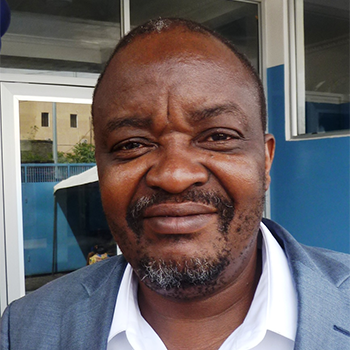
Dr. Christophe Kimona, director and surgeon of the REHEMA Medical Centre in Goma, 3 months internship 2017 in plastic surgery with Prof. Horch in Erlangen, financed by him and his Rotary Club Nuremberg.
Gabriel Mohimba was our driver in Goma and wanted to become a health officer at the health department. His studies from 2017 to 2021 were financed. He is now actively involved in the fight against Covid-19 in the Kivu-North province.

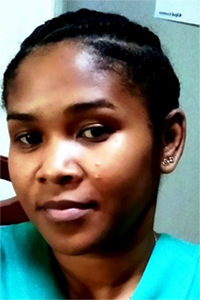
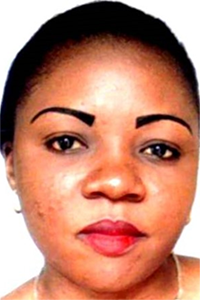
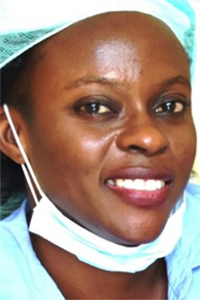
Dr. Harmonie Mitila from Kinshasa,
Dr. Emilie Amisi from Bukavu, and
Dr. Joee Maezevaka from Madagascar
assisted the Interplast teams and want to become plastic surgeons. The B.Braun Foundation financed the training 2017-2022 with a total of €30,000.
The “Power Boys”, 7 polio-paralyzed pupils with splints and crutches Riziki, Barutty, Baraka, David, Tresor, Jean Claude and later Elisha wanted to study. In 2017, they were given laptops and rickshaws to take cabs, a house to rent and their tuition fees paid for with around $50,000. From 2022, they will be working as lawyers, orthopaedic assistants, customs officers, health officers, shoemakers, development workers and economic officers.
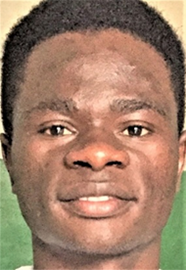


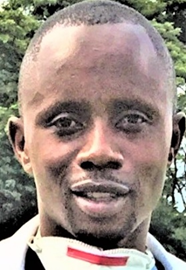
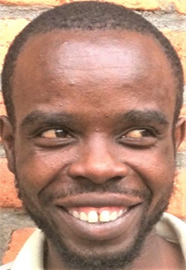
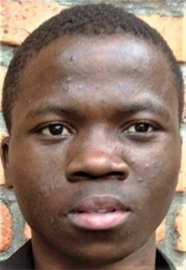
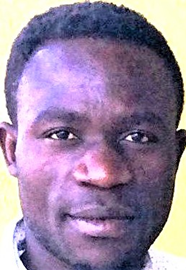
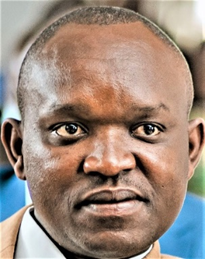
Hilaire Mulondwa received partial funding for his architecture studies in Beijing from 2017 to 2021, as he produced many good designs for the REHEMA hospital and took over its construction supervision.
Dr. Eric Kitoga has so far organized the patients for 5 Interplast teams in Goma and will also take over this position for future teams. He also keeps asking for medication such as chemotherapy, antibiotics and painkillers for the patients in Goma, which we pay for there.
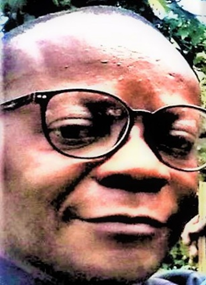

Dr. Ephraim Zibona trained as a laboratory doctor for the REHEMA Hospital in 2021. He is the head of medicine and pediatrics and is the most important physician involved in the development of the hospital with his ideas.
Dr. Voté Lwango received training as an X-ray and ultrasound specialist at the new REHEMA Hospital in 2021 and will head this department in future.
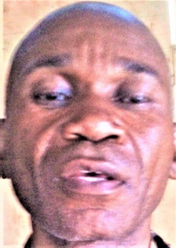
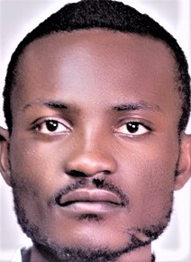
Messager Muhindo in Butembo is a student speaker, but had to drop out of his medical studies in 2021 due to financial hardship. However, an application to the B. Braun Foundation has enabled him to complete his studies.
Elisha Mulumbi is paralyzed and lives far away from the university in Goma. He has had his university fees paid since 2020 and in 2021 he got a cab for $2,000 to earn a living.
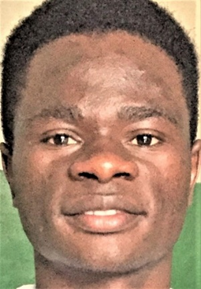

Dr. Justin Avris in Bukavu wants to become a plastic surgeon and has been receiving funding for his training at Panzi Hospital in Bukavu since 2020.
David Olivares, polio paraplegic and orthopaedic nurse, wants to become an orthopaedic surgeon and has been collecting patients for prosthetic legs, splints, wheelchairs and special shoes, which we are financing, since 2019. He will study medicine in Goma until 2026.

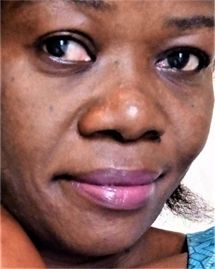
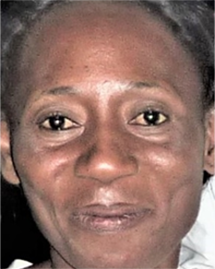

The previous op nurses Colette, Solange and Christina were financially supported for follow-up treatment and with medication and operations for their relatives.
Gottfried Lemperle, Frankfurt am Main, Germany
Author : Hans Jakob
When : June 06, 2021
About : The 1st mission in Kinshasa, July 2019

Pre-operated ameloblastoma of the mandible, ...
Congo is the richest country in the world in terms of natural resources, but its people are the poorest and most backward because they receive no support or investment from the West due to pervasive corruption (President Joseph Kabila has stashed $15 billion in Switzerland). Only China is buying into the Congo by constructing roads and buildings - with an eye on possible diamonds and coltan for their computers and cell phones. Kinshasa, a city of 12 million people, consists of a small western center on the Congo River and countless chaotic suburbs on the surrounding hills, albeit with a very pleasant climate.
In Congo, whose territory is as large as Western Europe and has 80 million inhabitants, there is 1 doctor for every 10,000 inhabitants. In terms of gross domestic product (GDP) and the Human Development Index (HDI), it ranks third to last among all countries, ahead of Mozambique and Niger.
Our team consisted of plastic surgeon Dr. Prakash Chhajlani from Indore, India, and anaesthetist Dr. Paul Schüller from Traunstein, who have both been involved in countless Interplast missions since 1984, last year's medical student Linda Kaschny from Bad Homburg, and Gottfried Lemperle from Frankfurt. Dr. Heinz Schöneich from Munich, who works mainly in Myanmar, joined later with Paul directly from an Interplast mission in Tanga, Tanzania.
Dr. Harmonie Linda Mitila, who had already operated with us three times in Goma, had prepared the camp in collaboration with the Health Ministry in Kinshasa. The only plastic surgeon in Congo, Dr. Richard Batiteyan (trained in Belgium) and his assistant Dr. Frederick Moko, two experienced anaesthetists and four other young surgeons actively helped.
Instead of the agreed university hospital, the Health Ministry had allocated us a hospital in the suburb of Kinkole that had been closed down for years, in which there was a pavilion with a small operating theater and 3 patient rooms. A diesel generator was switched on for the operating lamps and our cell phones and with a little water, instruments and gowns could be washed and sterilized in a modern sterile unit. An anesthesia machine was leased and the necessary, very expensive anesthetics were purchased.
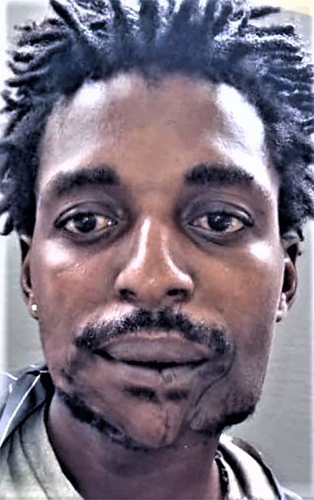
... this time radically removed with sub-optimal reconstruction of the lower jaw with a metal plate.
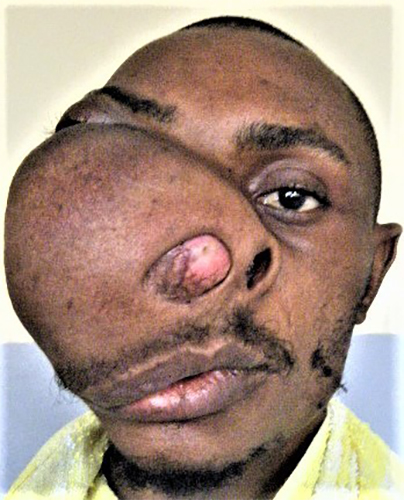
Fibrous dysplasia of the right maxilla developed within 12 years.
Most of the 88 patients operated on had large benign or malignant bone tumors in the face, which had often been operated on subradically years ago, or extreme burn contractures, mainly on the elbows and hands. Instead of the agreed 8 days of surgery, we could have operated for a whole month just to correct the most conspicuous disfigurements presented to us. However, with the equanimity typical of Africans, the patients with less pronounced tumors and contractures were put off until next year. In terms of congenital malformations, we only operated on one palatal fistula; in the capital, as in many places in Africa, newborns who cannot be married off later are handed over to the Congo.
The 28 patients with extreme facial tumors, many of whom had already undergone surgery, and the 20 or so with burn contractures on their arms and hands were patient and satisfied postoperatively. They tolerated their restrictions in an exemplary manner and all wounds healed without complications and without any significant infections despite the lack of hygiene in the operating theater.
We would like to thank Pro-Interplast e.V., which made this operation possible, as it has done so many times before, and Catgut GmbH in Markneukirchen, Serag-Wiessner GmbH in Naila for the necessary suture material, and Novidion in Cologne for the Pulox skin staplers.
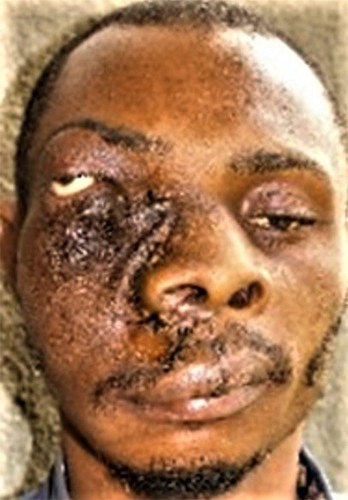
Radical extirpation and reconstruction with remaining periosteal bone flap.
Author : Hans Jakob
When : June 06, 2021
About : The 5th mission in Goma, June 2018
As in 2016 and 2017, the participants were Gottfried Lemperle, Katja Kassem, Carsten Schröder and Christoph Sachs. We once again operated in the operating room of Dr. Jean Maganga's private blood bank CEDIGO, as we were unable to gain access to any of the 5 larger hospitals in the city of millions.
The security situation continues to appear good, as a large number of local and international military personnel are stationed in Goma. The political situation in Congo remains unchanged, new elections are planned for December: Joseph Kabila, who is not allowed to run again, is likely to be elected for a 4th time as he has made opposition politicians disappear or keep them in prison. He has allegedly transferred 50 billion dollars to Switzerland. All African dictators bleed their people dry and only manage to be re-elected with their military.
The infrastructural situation in Goma continues to improve, albeit slowly. The increase in street lighting and asphalted roads is striking. Dr. Maganga and the local Church of the Nazarene again announced our mission on the radio and in the local media, so that around 400 patients also found their way to Goma from the remote villages in the rebel areas, some of them over 100 kilometers away.
This year's mission once again focused on the involvement and training of the two former colleagues Harmonie Mitila from Kinshasa and Emilie Amisi from Bukavu, as well as the four local assistants. The latter were committed to operating on around 120 patients with keloids, lipomas, atheromas and ganglions on a shared bed by the window. Harmonie and Emilie also operated largely independently on approx. 50 larger skin tumors and contracted scars, leaving our team with approx. 80 large facial tumors and extensive burn contractures under anesthesia, plexus or spinal anesthesia. A total of 303 were largely relieved of their suffering in the 4 operating theaters in 10 operating days. As our aftercare physician Dr. Eric Kitoga reports, there were only two secondary healings: after excision of a large keloid and on Z-plasties on a burned arm.
Once again, all 400 patients were standing in the front garden of the hospital on the first Sunday, this time with a strikingly large number of grotesque head and neck tumors. As there is no surgical care in the province of Kivu-North, benign and malignant tumors are growing endlessly. In Goma itself, there is no X-ray or CT for the poor, nor any functioning pathology or chemotherapy, so that we could only assume the tumor diagnosis based on the medical history and the clinical and intra-operative findings - and had to operate radically accordingly. However, Katja Kassem took 30 tumor samples in formalin back to Germany for her pathologist. After our return flight, Dr. Kimona operated on another 30 patients with huge tumors; at the invitation of Prof. Horch and his Rotary Club Erlangen, he spent 6 weeks in March in the plastic surgery department of the University of Erlangen.
It is noticeable that the consistency of the annual assignments with the same medical staff means that cooperation with colleagues on site is getting better and better. We look forward to seeing each other, sometimes understand each other blindly, know the circumstances and possibilities, and communicate largely non-verbally. The structure in the clinic also increases from mission to mission, with our medical equipment and instruments remaining on site every year, which noticeably improves organization and patient care, but especially aftercare. This year, for example, a defibrillator with monitoring capability, several oxygen saturation clips and an electric dermatome were brought along and left there.
The need for plastic surgery care in eastern Congo continues to be immense, so that once again this year numerous patients had to be put off until next year. In cooperation with the University of Goma, the local colleagues founded “Interplast-Goma” during our stay in order to continue the Interplast idea (www.interplast-germany.de). With the status of a non-governmental organization (NGO), they hope to acquire public funds and donations locally.
As the increase in the number of local colleagues accompanying our missions and the private-sector use of CEDIGO Hospital mean that capacity limits are inevitable, the existing outpatient clinic of the Church of the Nazarene is to be expanded with an operating theatre and beds in order to set up our own surgical center in Goma. A corresponding application has been submitted to the BMZ in Bonn - which rejected our application for a 2-storey hospital in Goma in spring 2018 on the grounds of a lack of sustainability.
As part of the next mission in April 2019, a new treatment center in Bukavu, at the southern end of Lake Kivu, will also be investigated. Pre-operative diagnostics and post-operative patient care could be significantly improved in a university hospital there. At the invitation of the Congolese Minister of Health, Gottfried Lemperle will fly to the capital Kinshasa in October, where Harmonie will organize a first Interplast camp in its university hospital.
We would again like to thank Pro-Interplast Seligenstadt e.V. for the financial support of our mission, and the companies Catgut GmbH, Combustin GmbH, Paul Hartmann AG, MIP-Pharma, Novidion GmbH, and Serag-Wiesner AG for an incredible amount of surgical materials for the more than 300 operations in Goma.
Christoph Sachs, Berlin, Germany
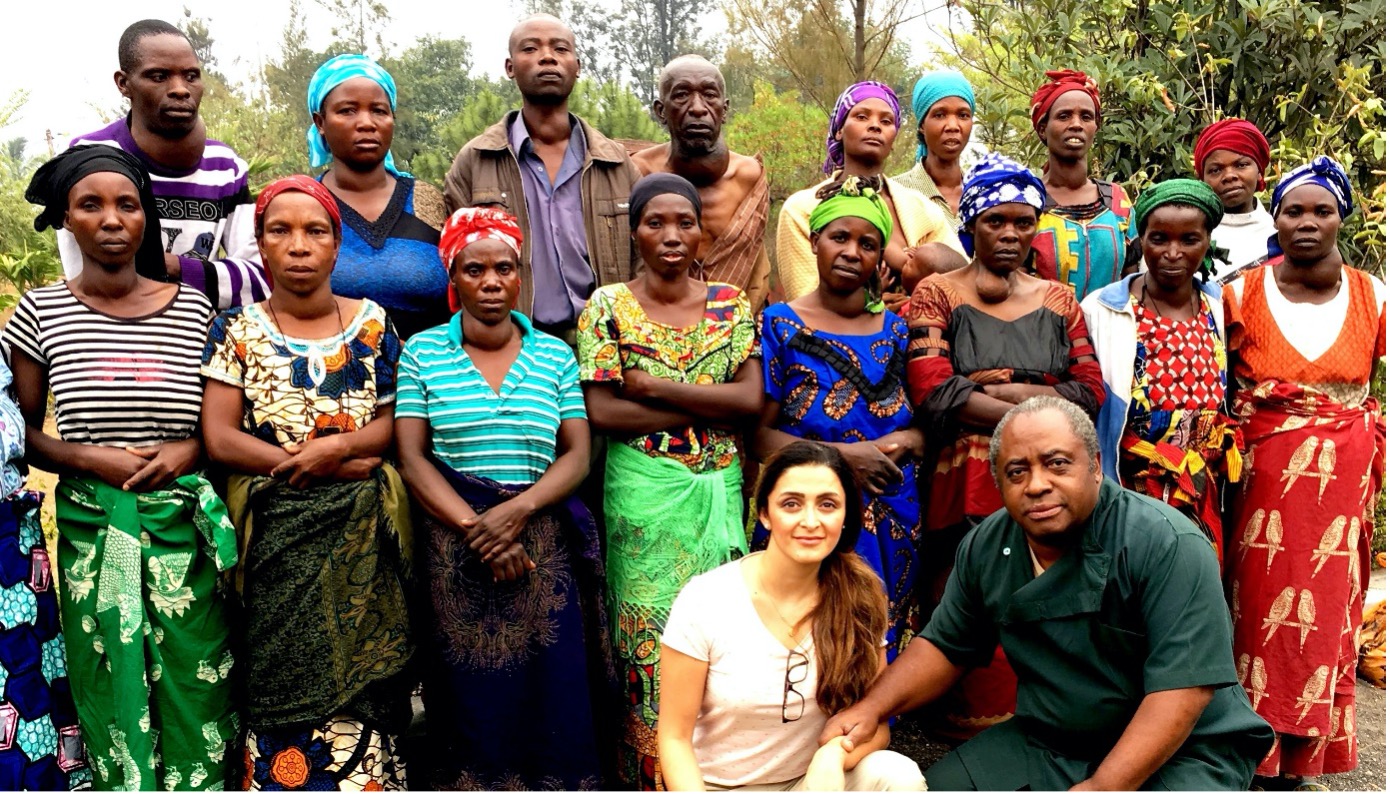
Author : Hans Jakob
When : January 2022
Where : Rehema Goma Hospital
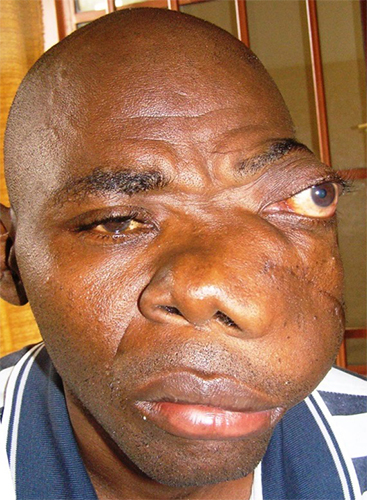
Rapidly growing Burkitt's lymphoma recurrence from 2016 ...
Our team from 2016 urged me to accompany them to Goma again in July 2017. The city of millions on Lake Kivu in the east of the Democratic Republic of Congo (DRC) has made a huge leap towards becoming an economic center in the last year thanks to extensive road construction by the Chinese and solar lighting of the roads by Germany. Anyone who thinks that cities in China with millions of inhabitants are overcrowded should drive through Goma!
On July 2, 2017, around 400 patients from all parts of North Kivu once again stood outside the small CEDIGO hospital in Goma, including a striking number of large facial and neck tumors, mostly Burkitt's lymphomas, ameloblastomas and sarcomas, goiters, few burn contractures, and this time no clefts. Unfortunately, we had little influence on the selection of the 20 patients, who were always already HIV-tested and changed in front of the operating theater during the following 8 days of surgery.
As I had invited the two young surgeons from last year, Dr. Harmonie Mitila from Kinshasa and Dr. Emilie Amisi from Bukavo, back, our team led by Christoph Sachs from Berlin, Katja Kassem from Donaueschingen and anaesthetist Carsten Schröder were able to work on two operating tables and operate on tumors and keloids locally on a bed with two patients each.
My grandson Johannes Schierle, a medical student in Groningen, was also there to help out in the operating room and find out for his Bachelor's thesis which keloids in Africa can be surgically removed without subsequent TRIAM injections. We had brought the doctor at the Church of the Nazarenes in Goma, Dr. Eric Kitoga, an injection gun with 200 ampoules of TRIAM and instructed him to photograph all keloids and their post-operative scars and, if necessary, to treat them with TRIAM.
On Saturday, we operated again at the Red Cross Hospital in Goma, where we covered three decubiti of a boy with local flaps and reconstructed the anterior lower jaw of two young men with an iliac crest and osteosynthesis plate. Amazingly, I have already seen six young men in Goma who all had their lower jaw shot through from below - with no other injuries to the face or thorax. No one told the truth about this shot: punishment or extortion? This reminded me of Tanzania, where I once reconstructed a banker's right ear, which had allegedly been severed in an accident, from rib cartilage (according to Pitanguy) - and three days later five other young men appeared in hospital with a missing right ear. I learned from a surgical nurse that in some parts of Tanzania this is still the punishment for serious theft.
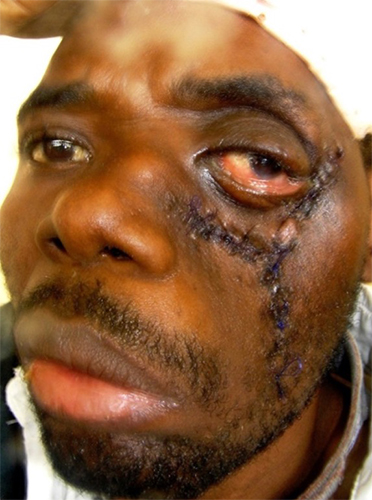
... and after resection of the orbital floor, maxilla, nasal wall and half the palate. The left base of the skull is infiltrated; there is neither radiation nor chemotherapy in Goma. We are hoping for chemotherapy across the border in Rwanda.
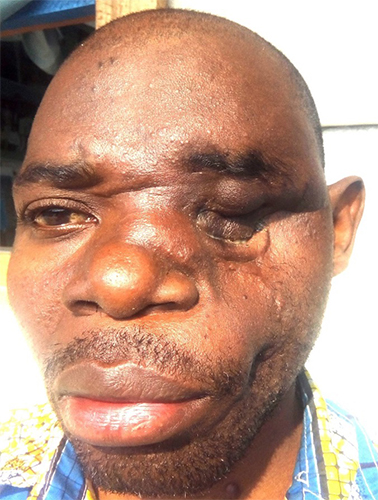
One year later, the tumor had infiltrated the entire eye socket, so we had to remove all the walls up to the exposed brain. The brain was suspended watertight from a wide strip of temporal fascia.
In total, the five of us freed 207 patients from their more or less burdensome tumors or contractures over eight days of surgery, probably saving the lives of six patients with large sarcomas. Our anesthesiologist tried to teach the local anesthesia nurse the basic concepts of modern anesthesia under the most difficult monitoring conditions. The two OR nurses Synthia and Colette also deserve enormous praise for sterilizing and preparing 20 instrument tables every day and serving four surgeons at the same time! - as well as the 2 ward nurses and 4 washerwomen who cleaned everything overnight. After our departure, Dr. Kimona operated on another 20 patients with huge, endemic thrombi, which we were unable to send back to the rebel areas without surgery. This brings the number of patients operated on during this mission to 227.
We would especially like to thank the head of the hospital, Dr. Jean Maganga, for making his rooms and staff available for two weeks, Dr. Christophe Kimona, whom Prof. Raimund Horch had invited to Erlangen for six weeks, for operating on the remaining 20 large strums from North Kivu, where no doctor currently dares to go. And of course Katja, Christoph and Carsten, who never lost their nerve and sense of humor in the face of some bloody operations and poor lighting. Many thanks also to Pro-Interplast for financing our flights and hotel costs. And again to the companies Catgut GmbH, Serag-Wiessner GmbH, Paul-Hartmann AG, Combustin GmbH, MIP Pharma GmbH, Novidion GmbH, pfm Medical AG, and the pharmacist Sylvia Pöhlmann in Margetshöchheim and PD.Dr.Dr. Würzler for valuable surgical material.
Gottfried Lemperle
Author : Hans Jakob
When : January 11, 2022
About : The 3rd mission in Goma, August 2016
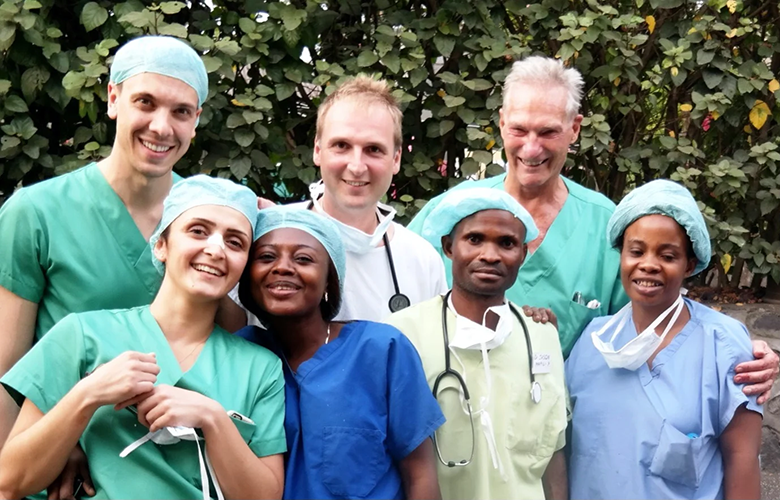
The team: Christoph, Katja, Colette, Carsten, Jason, Gottfried, Cynthia.
Gottfried Lemperle had already reported on the first two missions in Goma, Democratic Republic of Congo. This time he found another enthusiastic team in us: the plastic surgeons Christoph Sachs from Martin Luther Hospital in Berlin and Katja Kassem from Donaueschingen, and Carsten Schröder, an anaesthetist in Zurich (Fig. 1). ).
What Gottfried considers particularly important: the involvement of local surgeons and anaesthetists: Dr. Christophe Kimona, a former surgical chief physician and intended for our new hospital, Dr. Harmony Linda Mitila, 3rd year surgeon, assistant Dr.Emilie Amisi, as well as the anaesthesia nurses Jason, Castram and Christian, and the operating nurses Colette and Cynthia. The local surgeons should also be able to care for their plastic surgery patients themselves at some point!
We were again invited by the Church of the Nazarene in Goma and its Reverend Balibanga, who convinced Dr. John Maganga at CEDIGO Hospital to also allow a third Interplast team to operate in his hospital. We flew via Addis Ababa to Goma, which was able to reopen its airport, which was flooded by lava in 2002, on February 20, 2015 with financial help from Germany and Foreign Minister Steinmeier.
Previously, a modernized Dräger anaesthesia machine and surgical materials begged for late by Katja arrived there in 4 super metal crates, which the company Haas Logistig GmbH in Dunningen donated and shipped to Goma free of charge. Customs duties are levied everywhere in Africa not according to regulations but at the discretion of the local officer: Reverend Balibanga, however, knew his flock - and probably gave him a more important indulgence blessing instead of customs duties.
The Cedigo Hospital, today more of a blood bank that earns more money than surgery, was already familiar with the power with which Interplast teams operate and was well prepared. In the approx. 30 square meter operating room there were 2 operating tables, the German anesthesia machine, a new second operating lamp, a suction device and 2 shelves for local, bandages and sutures. But still no running water. The 3 x 4 suitcases and boxes were unpacked under the eager eyes of the staff, as we again brought laptops, cameras and watches with us and left them our suitcases again.
Dr. Eric from the Church of the Nazarene had taken the medical histories of around 400 patients, photographed them and called in 50 per day of surgery. They sat patiently on the lawn in front of the hospital as we selected the patients to be operated on the next morning - as we did every morning: approx. 5 large facial tumors under anesthesia, 10 contracted hands or legs under conduction anesthesia, and approx. 20 keloids (Fig. 2 and 3) and smaller excisions under local anesthesia. We moved the bed in the “recovery room” with the head end to the window so that 2 female or male patients could be placed there together, who were then operated on by Drs. Harmonie and Emily: many large mature keloids, breast tumors, facial scars, neurofibromas, etc.
Our hands were disinfected with some soap and water from a bucket, and a few squirts of Sterisept. According to Dr. Eric, who continued to look after all the patients after we left, there was not one post-operative infection and all the skin grafts healed satisfactorily.
Gottfried had brought Dr. Eric a Dermojet inoculation gun, which is normally used by veterinarians, with 2 x 100 ampoules of TRIAM 40 to either reduce the size of fresh keloids or to prevent the keloids we had operated on from recurring after 2-3 months. Gottfried believes that the cause of most keloids was an infection - and that recurrences after excision of “mature” keloids only occur after renewed post-operative infection. He therefore forced us to apply gentamicin or cefalotin to the still open wound before closing it.
Carsten took great care of the 3 “anesthesiologists”, who did not have much theoretical knowledge. Christoph and Katja took care of the many “frozen hands” and burns, Gottfried operated on 6 large facial tumors (fibrodyplasias, sarcomas) and supervised the simpler excisions by Harmony and Emilie at the window - and Katja knew how to keep the two surgical nurses and cleaning ladies happy and laughing loudly.
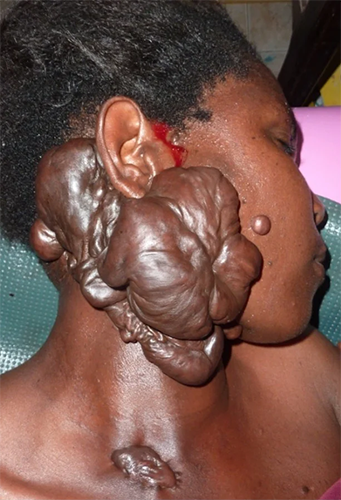
“Mature” keloid that has allegedly stopped growing 2 years ago - and is therefore an indication for surgery.
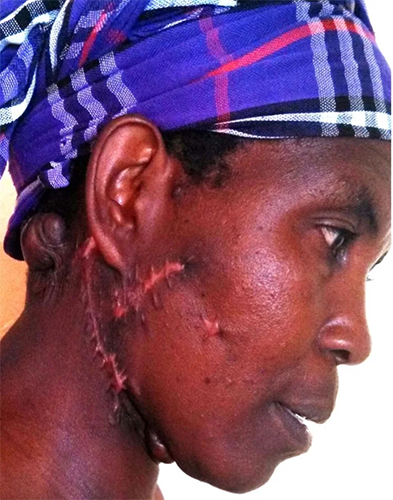
4 weeks after the excision: if recurrences developed, the follow-up physician had a TRIAM gun at hand, but it was not necessary to use it.
Without their good humor and their diligent washing and disinfecting of the instruments (mostly in a solution, but also in their leaky autoclave), we would not have been able to perform up to 20 operations a day. In 10 days of surgery, a total of 187 patients were operated on, 18 under general anesthesia, 20 under spinal or conduction anesthesia, 16 under analgosedation, and 133 under local anesthesia. In the more distant Ndoso Hospital of the International Red Cross, Gottfried and Carsten operated again on the two mutilated gold diggers from the previous year, as well as 2 patients with central gunshot wounds to the face.
We hardly had to worry about aftercare: in each of the 3 patient rooms, there were often 6-9 patients lying together in the 3 beds or on the floor. As soon as they were able to stand, they were discharged and often made their way home on the motorcycle cabs, i.e. still in a daze, wedged between the driver and their relatives.
Harmony and Emily were extremely committed and usually operated on their own from morning to night. Harmony is now doing her surgical training in Kinshasa, - and Katja convinced Eric to name his 3rd newborn daughter Frieda instead of “Gottfried”, probably in gratitude for a new laptop and the vaccination gun with which he is supposed to earn a little extra per shot from the wealthier keloid patients.
We would like to thank Aesculap AG in Tuttlingen, Haas Logistic GmbH in Dunningen, Einhorn Apotheke in Blumberg, Ms. Almut Meyer, Schwarzwald-Baar Klinikum, and Liberi pacifer e.V. - without whose help this mission would not have been possible.
Katja Kassem, Donaueschingen, Germany
Author : Hans Jakob
When : July and October 2015
About : The 1st and 2nd mission in Goma

“Church in Action” believes not only in the power of prayer, but also in God's work through it in the world. You just have to use your talents where they are urgently needed. Twenty young Christians from Frankfurt set off for Goma in Congo from 21 to 31 July 2015 to build schools, set up computer labs and train teachers. My son Andreas, an architect, invited me to help: finding patients and a hospital would be no problem. Thomas Biesgen from Trier and Michaela Hladik from Salzburg decided to fly along at short notice. Unfortunately, we did not receive a visa from Congo for an anesthesiologist within 3 weeks.
Congo is the richest country in Africa in terms of minerals, but ranks second to last on the “human development index” worldwide (ahead of Niger) due to corruption and civil wars. Goma is the border town to Rwanda, where 500,000 Tutsis fled from the Hutu massacres in 1994. Since then, Rwanda has been swimming in aid money; in Goma, a city of millions, there is only one paved road, no running water and still no land connection to the capital Kinshasa. Since the rebels made peace with the government in 2013, it has been absolutely safe in the big cities.
We landed in Kigali, Rwanda, and traveled the 180 km on the Chinese-built super road by bus to Goma, picturesquely situated on Lake Kivu. In 2002, a volcano 20 km from the city center had erupted and reduced the north of the city to rubble. Probably the dirtiest roads in the world consist of lava chunks and ash on which only the large SUVs of the many
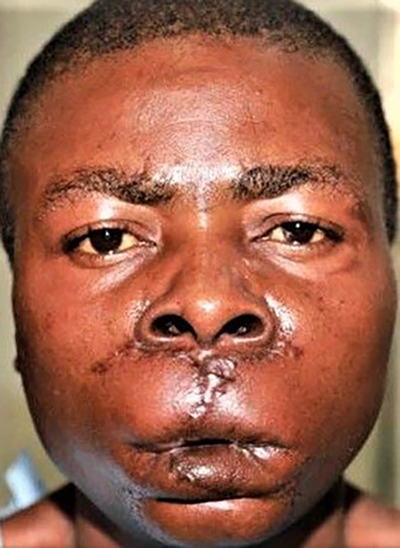
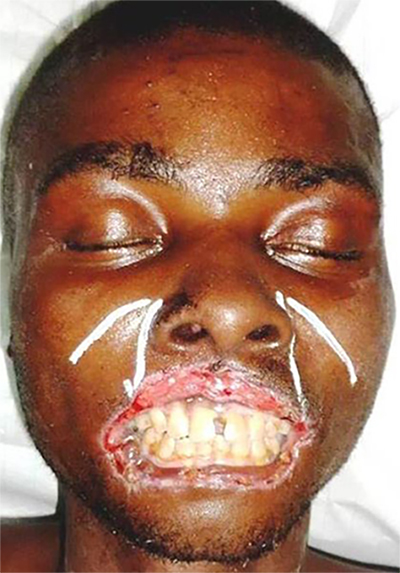
The small hospital that invited us belongs to a doctor, Dr. Maganga, who spontaneously attracted 450 patients with plastic surgery problems via radio. After huge keloids and lymphoedema, which we had to send home, we were left with large tumors, burn contractures and “frozen hands”, which we treated with large Z-plasties and full-thickness skin grafts in 35 patients in 5 days of surgery. All Z-plasties and grafts healed well. Thomas and Michaela operated on 3 cleft lips and a palate until we had to leave them to a later Interplast team due to a lack of trust in the local anesthetists (throughout Africa they are anesthesia assistants with 3 years of training).
A surgeon from another NGO hospital had heard about us and brought us to two horribly mangled young men. Two weeks earlier, marauding soldiers had invaded a village far to the north of Goma and asked the inhabitants, under threat of torture, who had found gold there. One of them then pointed to these two friends, probably under pressure. When the two denied several times, the soldiers cut off their fingers one by one, then both ears, and when they found the gold in their hut, they also cut off their entire upper and lower lips: “You will never lie like this again!” ... The devil is among us every day.
We had to mobilize the entire remaining mid-face up to the missing ears and lift a visor flap from the neck to at least cover the exposed gingiva. A visor flap from the forehead would have further compromised the damaged face, but a split free flap from the forearm would probably have been a better choice!
During a second operation from October 13 to 22, 2015 with Arthur Charpentier from Bonn, we were able to operate on the two gold seekers a second time and pull the two halves of the face of the younger one even further towards the middle. We also managed to operate on another 50 patients with huge tumors, burn contractures and gunshot wounds in 5 days. All reportedly healed well.
We would like to thank the companies Catgut GmbH, Novidion, Combustin, MPI-saar and Smith&Nephew for their spontaneous donations of large quantities of suture material, staplers, antibiotics, lidocaine and bandages. And the Erbe company for 2 Erbotomes! And of course Pro-Interplast in Seligenstadt and Interplast-Germany for their constant financial support!
Gottfried Lemperle, Frankfurt, Germany
Arthur Charpentier, Bonn, Germany
